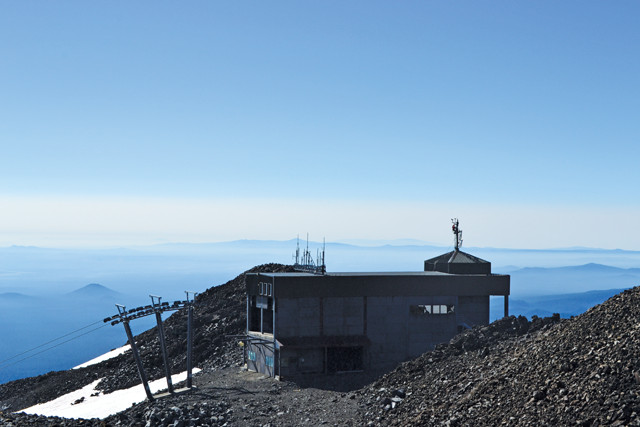
by Sam Lemonick Monday, May 15, 2017

In June 2015, tropospheric ozone levels measured at the observatory on Oregon's Mount Bachelor were more than 20 percent above the decadal average. Credit: Pao Baylon.
In June 2015, instruments on Oregon’s Mount Bachelor recorded mean ozone for the month at 56 parts per billion, more than 20 percent higher than the average level for the 11 years prior. Other stations around the West noted similarly high readings, puzzling scientists over the cause of the rise. In a new study in Geophysical Research Letters, researchers describe a confluence of meteorological conditions that appear to have driven the phenomenon.
The ozone observed is the same molecule that, in the stratosphere, shields us from damaging solar ultraviolet radiation. At ground level, however, ozone is a pollutant created in photochemical reactions following fossil fuel combustion that can cause serious respiratory problems.
The big jump in ozone in 2015 took Dan Jaffe, an atmospheric chemist at the University of Washington Bothell (UW-Bothell) who has monitored ozone in the Pacific Northwest for 20 years and operates the observatory on Mount Bachelor, by surprise. “The first thing we thought is that our instruments were all broken,” he says. But when he realized other stations were seeing the jump too, he and postdoctoral researcher Lei Zhang, also at UW-Bothell, went looking for a reason.
In the new study, Jaffe and Zhang noted that surface air temperatures in western U.S. states were as much as 6 degrees Celsius higher in 2015 because of a large, unusually warm parcel of water in the northern Pacific Ocean dubbed “the Blob.” The cause of the Blob, which stretched more than 2,000 kilometers at its peak, is still unknown, but sea-surface temperatures were about 2.5 degrees Celsius warmer than normal, which, in turn, raised air temperatures. The higher temperatures sped up the chemical reactions that make ozone, Jaffe says.
Accompanying the Blob — and maybe helping fuel it — was an abnormal high-pressure ridge in the atmosphere that pushed winds that would normally hit the Pacific Northwest up into Canada. Jaffe and Zhang reported that wind speeds in June 2015 were almost 20 percent lower than average for that time of year. Without those winds blowing, pollutants like ozone persisted longer, Jaffe says.
A third piece of the puzzle is cloud cover. Jaffe and Zhang looked at NASA satellite data and found that the Pacific Northwest saw about 25 percent more sunshine that June than it had on average over the 12 previous Junes. Because ozone is made by photochemical reactions, Jaffe says, that meant more pollution. It is also likely, the researchers noted, that during that warmer period, trees and plants were releasing more hydrocarbon molecules like isoprene and monoterpenes, for reasons biologists are still debating. Those molecules can also be ozone precursors, and could have further contributed to the elevated levels in 2015.
Beyond meteorological explanations, Jaffe and Zhang considered whether the increased ozone could have resulted from higher emissions from car exhaust or industrial activity regionally. So they looked to see if other pollutants, like carbon monoxide, were also elevated. They weren’t. And, they found, the extra ozone hadn’t migrated across the Pacific from China and other industrialized Asian countries either.
The research shows how complex the relationship is between ozone and weather, according to Allison Steiner, an atmospheric scientist at the University of Michigan who was not involved in the study. She calls Jaffe and Zhang’s findings unique, saying the paper shows how ozone anomalies can be caused by relatively localized meteorological patterns.
Increased pollution resulting from warming temperatures and changing weather is what’s known as the “climate penalty,” Jaffe says. “Even though we’re cleaning up our primary pollutants, as climate gets warmer we have to work even harder to get ozone down.”
That could be a big problem in places where ozone levels are already high. Salt Lake City, Utah, for example, exceeded the Environmental Protection Agency’s ozone limits 16 days in June 2015. Jaffe says when he talked to air quality experts in Salt Lake City that year they had no idea why levels were so high. This new research gives some answers.
© 2008-2021. All rights reserved. Any copying, redistribution or retransmission of any of the contents of this service without the expressed written permission of the American Geosciences Institute is expressly prohibited. Click here for all copyright requests.